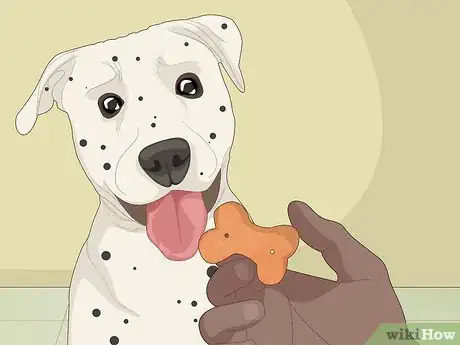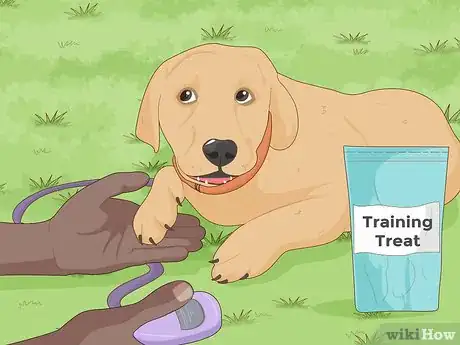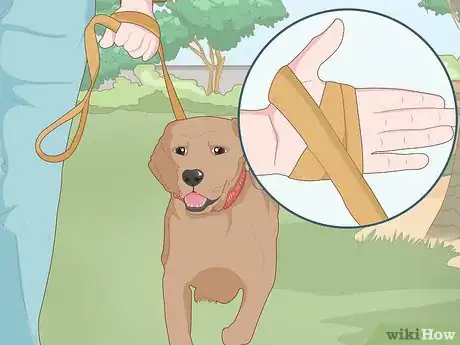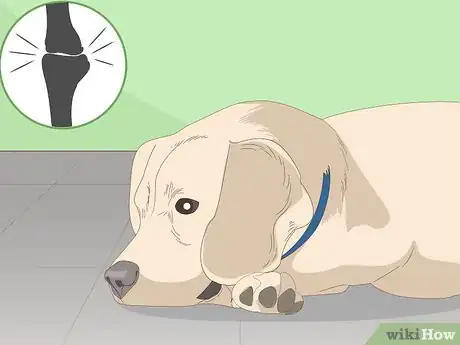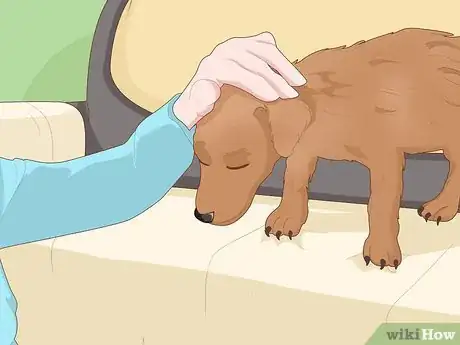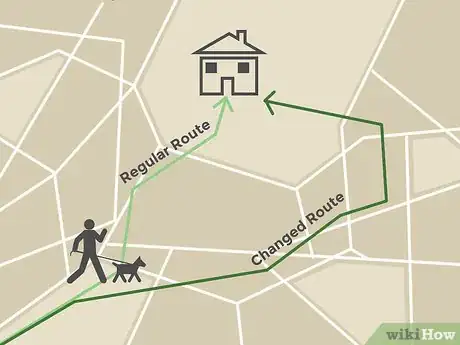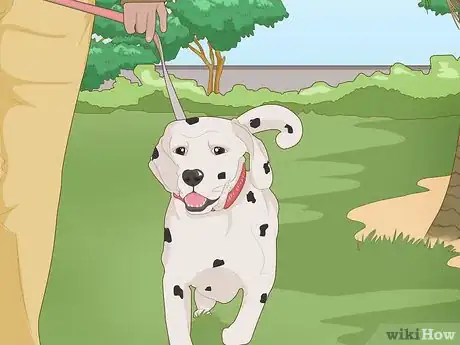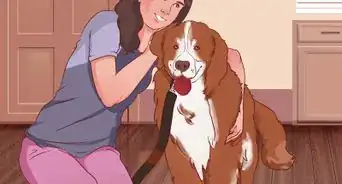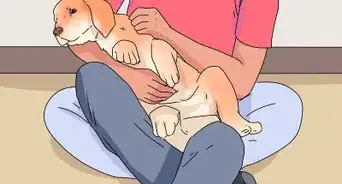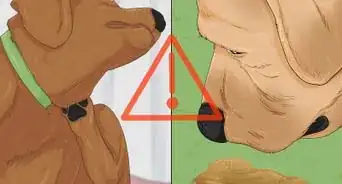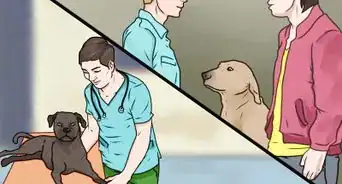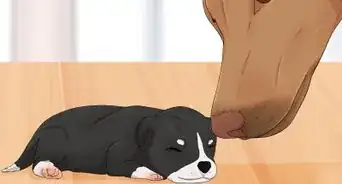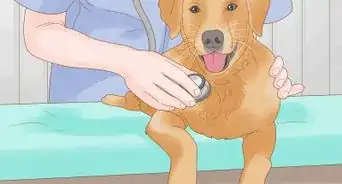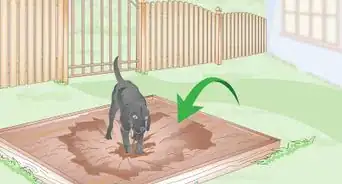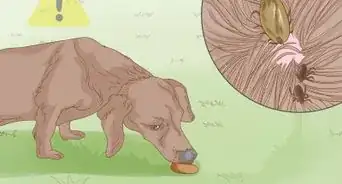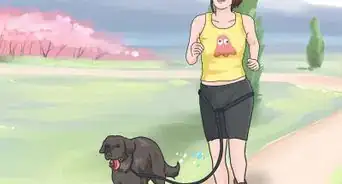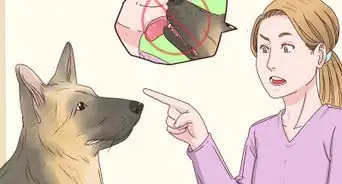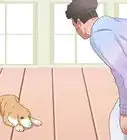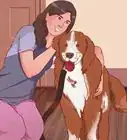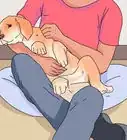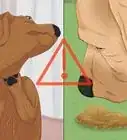This article was co-authored by David Levin. David Levin is the Owner of Citizen Hound, a professional dog walking business based in the San Francisco Bay Area. With over 9 years of professional dog walking and training experience, David's business has been voted the "Best Dog Walker SF" by Beast of the Bay for 2019, 2018, and 2017. Citizen Hound has also been ranked #1 Dog Walker by the SF Examiner and A-List in 2017, 2016, 2015. Citizen Hound prides themselves on their customer service, care, skill, and reputation.
This article has been viewed 53,922 times.
Walking with your dog can be one of the most enjoyable experiences, but if your dog is stubborn and refuses to go for a walk or be calm on the walk, the experience can quickly turn frustrating for both of you. Remember, dogs want to behave just as much as we want them to, so it's up to you to figure out what the problem is. Your dog might need training, it might have a medical condition, or it might just need a bit of stimulation.
Steps
Changing Your Dog’s Behavior
-
1Reward your dog for desired behaviors. Rather than scold your dog for not doing what you want, reward your dog for doing what you do want. By rewarding good behavior, you’re teaching your dog that they will receive a reward for doing something, and they will begin to positively associate good behavior with going for walks. On the other hand, if you yell at or hit your dog, they will only associate walks with something bad and become even more resistant.
- Yelling at your dog or physically disciplining them is never going to yield desired results. It will only make them fearful and anxious.
-
2Use small training treats and a click trainer. Dogs, like people, form associations between behaviors and positive experiences. When you reward your dog for desired behaviors, consider using small training treats and a click trainer. Wait until your dog has performed the behavior you want, such as walking forward, and then quickly, almost in unison, click the trainer and then offer the dog a small training treat. Your dog will associate walking forward with the click sound and treat, and ultimately you will be able to reward with a click sound rather than treat.[1]
- Use training treats, or break a large, soft treat up into small pieces. Training treats are small and soft by design so that they can be a reward, not be a distraction, and not fill your dog up.
- Click trainers are inexpensive and can be found at all pet stores.
Advertisement -
3Take charge of your dog. Taking charge simply means establishing that you are the dominant figure in the relationship between you and your dog. You will not take charge by hitting, kicking, yelling, or physically intimidating your dog. By being the person with the treats, the leash, the click trainer, the commands, and the person responsible for feeding and housing the dog, you’re already in the dominant position. When you’re on a walk with your stubborn dog, maintain that power dynamic by calmly giving commands and leading your dog where you’d like it to go.[2]
- You might get frustrated with your stubborn dog, but that’s no reason to lose your cool. Keep calm and focused, showing your dog that you’re in charge.
-
4Use the leash as a tool. The leash is, for all intents and purposes, an extension of your arm and an invaluable tool. The leash is an effective way for you to communicate what you want your dog to do, while making sure that they don’t leave your side when excited.[3]
- Put your hand through the leash and also wrap it once around your right hand.
- Hold the slack in the leash with your left hand.
- Gently pull on the leash if you need to so that you can remind your dog to behave.
- Never yank or pull hard on the leash and never hit your dog with the leash.
EXPERT TIPDavid Levin is the Owner of Citizen Hound, a professional dog walking business based in the San Francisco Bay Area. With over 9 years of professional dog walking and training experience, David's business has been voted the "Best Dog Walker SF" by Beast of the Bay for 2019, 2018, and 2017. Citizen Hound has also been ranked #1 Dog Walker by the SF Examiner and A-List in 2017, 2016, 2015. Citizen Hound prides themselves on their customer service, care, skill, and reputation.Professional Dog Walker
 David Levin
David Levin
Professional Dog WalkerConsider using a different leash if your dog is struggling with on-leash walking. If you're trying to train a stubborn dog to walk on a leash, you're probably going to need better equipment, like a head collar, which is designed similar to a horse's bridle. It's the closest thing to a magic pill for dog handling, because you'll have control of the dog's snout, and the body will follow the head. It may take a little time for the dog to become comfortable with the halter, but if you're patient, the dog can learn.
-
5Pair verbal and non-verbal commands. Pairing a verbal command with a non-verbal command is the most effective way to tell your dog what you want them to do. When you teach your dog the commands, pair the verbal command with a hand signal and a training treat. Ultimately you will remove the treats and just use the hand signals and verbal commands.
- You can teach your stubborn dog the “let’s go” command, which indicates that you’re both going to walk forward.
- You can also teach the “stop” command, which alerts your dog that they are to stop walking.
Evaluating Your Dog’s Health
-
1Consider that your dog may be in pain. Your dog may be resisting going for walks, but it might not be because they’re stubborn, but because they are in pain. If your dog has gradually or even suddenly decided it is no longer interested in walks, this change in behavior could be a good indicator that they’re hurting. Get your dog to the veterinarian for an examination.
- Your dog could have arthritis, which is a painful condition involving the joints.
- Your dog may have sustained an injury, such as to the pad of their foot or to a muscle or tendon.
-
2Have your dog evaluated for dementia. Dogs, like people, can develop diseases, such as Alzheimer’s and dementia, that impact how they sense the world around them. If your dog becomes fearful of going for walks or their behavior changes, take your dog to a veterinarian for evaluation.[4]
- These are progressive diseases, and your vet will discuss any and all viable treatment options.
- Even if you are only able to tell your vet that your dog seems “off” or “different”, with a few examples, may be enough to help them determine if your dog likely has dementia or not.
-
3Treat your dog for anxiety. Some dogs have anxiety, and if your dog is one that does, your dog may appear stubborn when you try to take it for a walk. Because dogs can’t articulate themselves verbally, it might be difficult to distinguish between anxiety and stubborn behavior. Take your dog to the vet and explain the behavior changes. Your vet may prescribe anti-anxiety medications that should help your dog be more comfortable going for walks.[5]
- Some signs of anxiety in dogs include panting, curling their tail between their legs, drooling, crouching low to the ground, and hiding.
Challenging Your Dog Mentally
-
1Take a new route. Just like people, dogs can get bored easily. Your dog may be acting stubborn on walks because it is bored. Take a different route on your walk, or go to another park or neighborhood altogether for your walk. Even walking the same neighborhood but in a different pattern may be enough to make the trip exciting again for your pup.[6]
- Try taking the route that you normally take but in reverse, if possible.
-
2Go to a new location. Another way to mentally stimulate your dog is to take it to a new place for a run or walk. Introducing your dog to new sights, sounds, and smells stimulates your dog mentally and physically, and should make them eager for that walk that they’ve been resisting.[7]
- Check if your county or city has a dog park.
- There might also be a state or national park nearby that allows dogs.
- Even if you take your dog to a designated off-leash area, make sure that you have a leash on hand at all times.
-
3Use reverse psychology. Your dog may expect that they know exactly how this is all going to happen: you’re going to put the leash on them, you’re going to start walking, and you’re going to take that same boring route that you always take. Instead, give your dog the stay command and make them hold the position. Then, tell your dog to go, rewarding them for moving. This simple “reboot” in your walking routine might be just the trick to getting your dog to walk without issues.
- You will need to decide early on what commands you’ll use with your dog, including what you’ll use for “stay” and “go.”
-
4Desensitize your dog. Your dog may be a stubborn walker because they fear some part of the experience, be it the leash, passing cars, or simply walking around outside their home. Desensitization is a lengthy process in which you introduce your dog to graduating levels of the stimuli that they fear. The idea is that as they become comfortable with a low level of the stimuli, you add a bit more until they are again comfortable. Desensitizing your dog may be the key to your dog becoming happy to go on walks.[8]
- Desensitization takes a lot of patience. Don’t expect results overnight and don’t lose your cool if your dog doesn’t respond right away.
- Make sure that you don’t overwhelm your dog and that you introduce small, graduating levels of the stimulus.
- For example, if your dog is uncomfortable with unfamiliar people, invite someone to come over to your house and sit in the yard, maybe in a chair while reading a book.
- Keep your dog on leash away from the person and allow them to smell the air. As they get comfortable, take a step toward the person, moving slightly closer every time your dog appears comfortable.
- Ultimately, your dog should be close enough that you can introduce your friend to the dog without a fear response from your pup.
- Don’t force your dog to approach the person. You follow their lead, not the other way around.
Community Q&A
-
QuestionMy three month-old puppy refuses to go for a walk. I finally get it going and it runs ahead of me, pulling on the leash, then suddenly halts and won't move. What should I do?
 Eliana CarratalaCommunity AnswerThis is because it is all new to them. Be patient. Get a special training halter, as this could solve your problem.
Eliana CarratalaCommunity AnswerThis is because it is all new to them. Be patient. Get a special training halter, as this could solve your problem. -
QuestionMy dog breaks down and doesn't move when we head home. Treats won't help. How do I get them to walk back?
 Community AnswerTry going another route, or try going for a longer walk so that he/she will be tired and want to go home when it's time.
Community AnswerTry going another route, or try going for a longer walk so that he/she will be tired and want to go home when it's time. -
QuestionMy year old dog keeps stopping and refusing to walk during routine walks or runs. Treats don't seem to help. What should I do?
 Community AnswerTry giving her a day or 2 to get some rest. If this doesn't work, you should probably visit a vet just to get some advice and make sure it is nothing serious.
Community AnswerTry giving her a day or 2 to get some rest. If this doesn't work, you should probably visit a vet just to get some advice and make sure it is nothing serious.
Things You'll Need
- Dog
- Treats
- Leash
- Collar
- Clicking trainer
References
- ↑ http://www.clickertraining.com/get-started
- ↑ https://www.animalhumanesociety.org/training/managing-leash-reactive-dog
- ↑ http://www.akc.org/learn/family-dog/teach-puppy-walk-leash/
- ↑ https://www.washingtonpost.com/posteverything/wp/2015/01/09/what-happens-when-your-dog-gets-alzheimers/
- ↑ https://www.washingtonpost.com/posteverything/wp/2015/01/09/what-happens-when-your-dog-gets-alzheimers/
- ↑ https://www.cesarsway.com/dog-training/walking/disinterested-in-the-walk
- ↑ https://www.cesarsway.com/dog-training/walking/disinterested-in-the-walk
- ↑ http://shibashake.com/dog/how-to-calm-a-fearful-reactive-dog
About This Article
To walk a stubborn dog, give it a treat whenever it walks forward or goes in the direction you want it to so that over time it associates walking with getting a reward. Avoid verbally or physically disciplining your dog since it will only make your dog more stubborn and difficult. Also, as you're walking your dog, gently pull on the leash as a reminder to behave and continue walking, but avoid yanking the leash or pulling hard on it. You can also try walking your dog on a different route every day so it's more mentally stimulated and eager to explore. To learn how to tell if your dog's stubbornness is the result of a health issue, scroll down!
